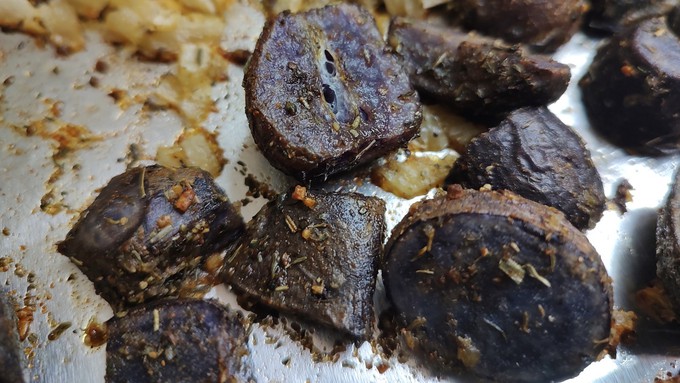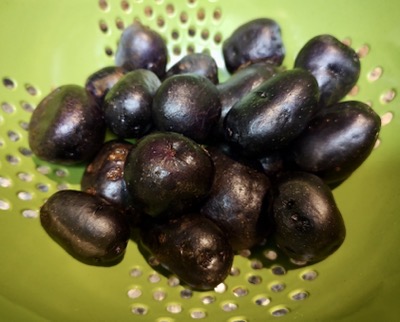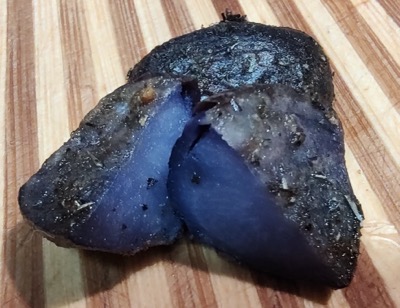
Recipe: Roasted purple potatoes with Provencal herbs

Unlike some purple vegetables, these potatoes retain their color when roasted. Debbie Arrington

Lavender flowers are part of the distinctive mixture that makes up Herbs de Provence, which also includes rosemary, marjoram, thyme, savory and other herbs native to southern France. Combined with garlic salt and coarse ground black pepper, this herb mix is a flavorful complement to roast potatoes – no matter the color.
Purple potatoes taste much like their white- or yellow-fleshed cousins (their flavor and texture are usually compared to russets). They tend to cook a little faster and don’t need peeling. They can be substituted into almost any recipe that calls for a starchy potato.
The main difference: Antioxidants. Purple potatoes have about three times the antioxidants of a white-fleshed potato.
Purple potatoes get their distinctive hue from anthocyanin, the same compound found in blueberries. Half a baked purple potato has just as much of this antioxidant as a half cup of blueberries.
Unlike some colorful veggies, purple potatoes retain their rich color when cooked, which makes them a fun food to try. (Purple fries, anyone?)
Try these roasted purple potatoes as a side dish to grilled or roast meat, fish or chicken.
Provencal purple potatoes
Makes 4 servings
Ingredients:
1 pound purple potatoes, washed and eyes removed
2 tablespoons olive oil
1 teaspoon Herbs de Provence
1 teaspoon garlic salt
½ teaspoon coarsely ground black pepper
½ cup chopped onion
Instructions:

Preheat oven to 400 degrees F.
Line a sheet pan with foil. Set aside.
Depending on size, cut purple potatoes into wedges or quarters.
In a large bowl, mix olive oil, herbs, garlic salt and pepper. Toss potatoes in herb mixture to coat and spread potatoes in foil-lined pan. Toss chopped onion in bowl with remaining oil and herbs, then add the onions to the potatoes in the sheet pan.
Bake in a 400-degree oven until the potatoes are fork tender, about 25 to 30 minutes. Serve.
Comments
0 comments have been posted.Sacramento Digs Gardening to your inbox.
Sites We Like
Garden Checklist for week of July 21
Your garden needs you!
* Keep your vegetable garden watered, mulched and weeded. Water before 8 a.m. to reduce the chance of fungal infection and to conserve moisture.
* Feed vegetable plants bone meal, rock phosphate or other fertilizers high in phosphate to stimulate more blooms and fruiting. (But wait until daily high temperatures drop out of the 100s.)
* Don’t let tomatoes wilt or dry out completely. Give tomatoes a deep watering two to three times a week.
* Harvest vegetables promptly to encourage plants to produce more. Squash especially tends to grow rapidly in hot weather. Keep an eye on zucchini.
* Pinch back chrysanthemums for bushy plants and more flowers in September.
* Remove spent flowers from roses, daylilies and other bloomers as they finish flowering.
* Pinch off blooms from basil so the plant will grow more leaves.
* Cut back lavender after flowering to promote a second bloom.
* It's not too late to add a splash of color. Plant petunias, snapdragons, zinnias and marigolds.
* From seed, plant corn, pumpkins, radishes, winter squash and sunflowers.